You are using an out of date browser. It may not display this or other websites correctly.
You should upgrade or use an alternative browser.
You should upgrade or use an alternative browser.
40.6 vs 41.0 pavilion angle
- Thread starter lksquare
- Start date
- Joined
- Aug 4, 2008
- Messages
- 15,510
- Joined
- Aug 15, 2000
- Messages
- 18,863
Table size will also make a difference and is needed to answer.
Let’s say table size 57… then 41 angle works. And if table 58.. then 40.6 is better? Am on the right track?
- Joined
- Aug 15, 2000
- Messages
- 18,863
Let’s say table size 57… then 41 angle works. And if table 58.. then 40.6 is better? Am on the right track?
I would say the other way around but I will wave this one to Karl.
My focus is tops and bottoms
- Joined
- Aug 4, 2008
- Messages
- 15,510
It actually the 34.5 CA that limits the table size but the limit is pretty high, over 60%.
I was checking to make sure we were not talking about oddballs.
Generally you will see 40.6 teamed up with 35ish and 41 teamed up with 34ish but for a table size 34.5 CA works with either is fine.
57 and 58 table are often lumped together because pretty much anything you can say for one you can say for the other.
If I was grouping table sizes it would be:
under 50
50-53
54-56
57-58
59-60
61-62
62+
I was checking to make sure we were not talking about oddballs.
Generally you will see 40.6 teamed up with 35ish and 41 teamed up with 34ish but for a table size 34.5 CA works with either is fine.
57 and 58 table are often lumped together because pretty much anything you can say for one you can say for the other.
If I was grouping table sizes it would be:
under 50
50-53
54-56
57-58
59-60
61-62
62+
It actually the 34.5 CA that limits the table size but the limit is pretty high, over 60%.
I was checking to make sure we were not talking about oddballs.
Generally you will see 40.6 teamed up with 35ish and 41 teamed up with 34ish but for a table size 34.5 CA works with either is fine.
57 and 58 table are often lumped together because pretty much anything you can say for one you can say for the other.
If I was grouping table sizes it would be:
under 50
50-53
54-56
57-58
59-60
61-62
62+
Awww… thank you!! That helps a lot and give me more frame of reference.
- Joined
- Aug 15, 2000
- Messages
- 18,863
It actually the 34.5 CA that limits the table size but the limit is pretty high, over 60%.
I was checking to make sure we were not talking about oddballs.
Generally you will see 40.6 teamed up with 35ish and 41 teamed up with 34ish but for a table size 34.5 CA works with either is fine.
57 and 58 table are often lumped together because pretty much anything you can say for one you can say for the other.
If I was grouping table sizes it would be:
under 50
50-53
54-56
57-58
59-60
61-62
62+
To split hairs, optimum table size also depends to a small extent on girdle thickness.
Thinner = smaller, thicker = bigger.
That is why Tolkowsky math indicated 53% - because he had no girdle at all. Adding the girdle requires bigger tables.
As per @jasper Paulsen at Folds.net
- Joined
- Aug 4, 2008
- Messages
- 15,510
To split hairs, optimum table size also depends to a small extent on girdle thickness.
Thinner = smaller, thicker = bigger.
That is why Tolkowsky math indicated 53% - because he had no girdle at all. Adding the girdle requires bigger tables.
As per @jasper Paulsen at Folds.net
This is just Garry and I having a little fun...
If you see a stone with a 10% girdle run away.
I never really played around with 10% gidles on tolk, bit surprising
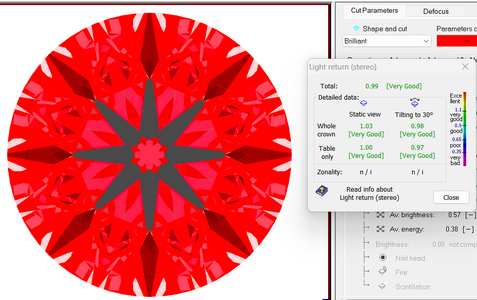 .
.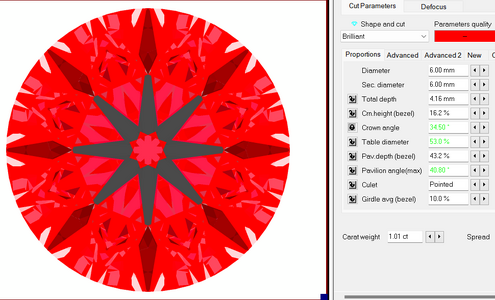
- Joined
- Aug 15, 2000
- Messages
- 18,863
- Joined
- Aug 4, 2008
- Messages
- 15,510
- Joined
- Aug 14, 2009
- Messages
- 27,485
Hey. @Karl_K. I think you’ve just created the world’s first non-warped diamond.
OMG print the book, y’all!!!
Which is a 40.6 or 41.0 better pavilion angle works better with a 34.5 crown angle? (I know 40.8 is optimal..) just curious what’s the better combo if 40.8 is another an option.
please compare 5 diamonds with same Crown angle 34.5 degree and Pavilion angles: 40.4, 40.6, 40.8, 41.0, 41.2

Pa variation for Ca34.5

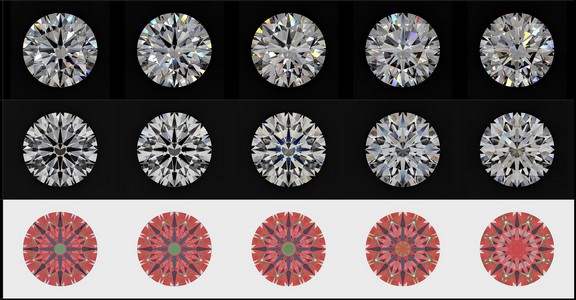

- Joined
- Aug 15, 2000
- Messages
- 18,863
please compare 5 diamonds with same Crown angle 34.5 degree and Pavilion angles: 40.4, 40.6, 40.8, 41.0, 41.2

Pa variation for Ca34.5
cutwise.com

Excellent Sergey, could you make the RI pavilion interface 1.4 or 1.5 for a real world comparison please?
Excellent Sergey, could you make the RI pavilion interface 1.4 or 1.5 for a real world comparison please?
Garry,
Was your HCA system developed for clean or dirty diamonds? If it is only accurate for dirty diamonds, how many HCA users are aware of this? If it was indeed designed for evaluating clean diamonds, why do I need to use RI glass instead of a diamond when calculating movies, fire, and brilliancy?
I live in a world where the RI of a diamond is 2.42, and where there is an opportunity to wear and admire clean diamonds using binocular vision. You made a strategic mistake long ago by introducing the concept of the "Dead ring," which does not take into account human binocular vision. It's high time to acknowledge this mistake and stop calling the real unreal. It's long overdue to allow consumers to wear clean diamonds and appreciate their beauty.
I find it difficult to understand how one could create a system to assess the beauty of dirty diamonds, as in the case of dirty diamonds, the differences in optical performance will primarily be caused by variations in the amount of dirt rather than differences in diamond proportions.
Who chooses clothing based on how it will look after a week of continuous wear without washing? Perhaps there are consumers who select clothing and diamonds based on how they will appear after extended wear without cleaning, but personally, I prefer to assist those who want to look beautiful in clean attire and admire clean diamonds. It's fortunate that diamonds can be cleaned easily without the need for ironing.
Who chooses clothing based on how it will look after a week of continuous wear without washing? Perhaps there are consumers who select clothing and diamonds based on how they will appear after extended wear without cleaning, but personally, I prefer to assist those who want to look beautiful in clean attire and admire clean diamonds. It's fortunate that diamonds can be cleaned easily without the need for ironing.
- Joined
- Aug 15, 2000
- Messages
- 18,863
Firstly Sergey,
HCA was designed for clean diamonds.
However, unlike any other system it gives bonus points for larger spread round diamonds. This means that compared to all other systems, it favours shallower diamonds.
Many people have challenged me on this over my "preference" without understanding that people like larger diamonds and hence my 'bonus'. As you know, I have done many real world comparisons and discovered the dirty diamond effect penalises slightly deeper diamonds.
Now I do prefer slightly shallower diamonds. It is also one reason CVD perform so well - as depth is a constraint vs diameter for natural diamond.
HCA was designed for clean diamonds.
However, unlike any other system it gives bonus points for larger spread round diamonds. This means that compared to all other systems, it favours shallower diamonds.
Many people have challenged me on this over my "preference" without understanding that people like larger diamonds and hence my 'bonus'. As you know, I have done many real world comparisons and discovered the dirty diamond effect penalises slightly deeper diamonds.
Now I do prefer slightly shallower diamonds. It is also one reason CVD perform so well - as depth is a constraint vs diameter for natural diamond.
- Joined
- Aug 15, 2000
- Messages
- 18,863
This is a binocular Ideal-scope image of CLEAN virtual a 41.2 degree pavilion diamond with a human head and 16 inch viewing distance. 12 inches is not much better and it is not until one gets to about 8 inches that your theory works a bit.Garry,..... where there is an opportunity to wear and admire clean diamonds using binocular vision. You made a strategic mistake long ago by introducing the concept of the "Dead ring," which does not take into account human binocular vision.

- Joined
- Aug 4, 2008
- Messages
- 15,510
Interesting thread, when Garry and Serg post, I read and learn. That does not mean I always agree but its a good opportunity to learn something.
As far as the dirty/clean debate: Garry is more right for earrings as you can clean them every hour and they will still be dirty on a hot or humid day.
Leave then on while using hairspray is like coating your diamonds with spray paint.
For rings where people tend to keep them cleaner and the distances can be much shorter I tend more towards the less reactive to obstruction but good contrast combinations.
Once you get overly steep deep they are compromised both ways.
There are some combos on the edges of steep deep and on the edges of to shallow that if well cut can work very well all around.
When you play around at the edges the minor facets lgf/stars(actualy the upper girdle angles are whats important but star% changes them for any given CA) are critical.
As far as the dirty/clean debate: Garry is more right for earrings as you can clean them every hour and they will still be dirty on a hot or humid day.
Leave then on while using hairspray is like coating your diamonds with spray paint.
For rings where people tend to keep them cleaner and the distances can be much shorter I tend more towards the less reactive to obstruction but good contrast combinations.
Once you get overly steep deep they are compromised both ways.
There are some combos on the edges of steep deep and on the edges of to shallow that if well cut can work very well all around.
When you play around at the edges the minor facets lgf/stars(actualy the upper girdle angles are whats important but star% changes them for any given CA) are critical.
Firstly Sergey,
HCA was designed for clean diamonds.
However, unlike any other system it gives bonus points for larger spread round diamonds. This means that compared to all other systems, it favours shallower diamonds.
Many people have challenged me on this over my "preference" without understanding that people like larger diamonds and hence my 'bonus'. As you know, I have done many real world comparisons and discovered the dirty diamond effect penalises slightly deeper diamonds.
Now I do prefer slightly shallower diamonds. It is also one reason CVD perform so well - as depth is a constraint vs diameter for natural diamond.
Great. In that case, you should stop requiring me to use the refractive index (RI) of glass instead of the RI of a diamond. It's essential to compare apples to apples.
The spread is much more dependent on the thickness of the girdle than the angle of the pavilion. It's very easy to create two diamonds where a diamond with a P 40.6 angle will have a worse spread than a diamond with P 41, and they will differ only in pavilion angles and slight variations in girdle thickness. However, the HCA will still favor the diamond with the P40.6 angle. Can you explain this if the HCA was designed for clean diamonds, and the diamond with P41 has more fire and especially "Life"? The pavilion angle is critical for "VF speed" = DETAS. Shallow diamonds have much less VF speed than diamonds with Cr34.5 P41-41.2 angles. Tools like ASET and IS are useless for evaluating Fire, "Life," DETAS, and Scintillation. Evaluation systems and even rejection tools cannot be comprehensive if they recognize vastly different "Life" values in cuts, if they evaluate only Light Return in one static position for a diamond observer with one eye in the center of the head. People are not cyclopses or cameras. Stereo vision and dynamics are more important for evaluating the beauty of a diamond than Light Return.
And which diamonds did you compare in your World Comparisons? How did you assess the difference in the degree of dirtiness between the compared diamonds in these comparisons?
- Joined
- Aug 15, 2000
- Messages
- 18,863
Great. In that case, you should stop requiring me to use the refractive index (RI) of glass instead of the RI of a diamond. It's essential to compare apples to apples.
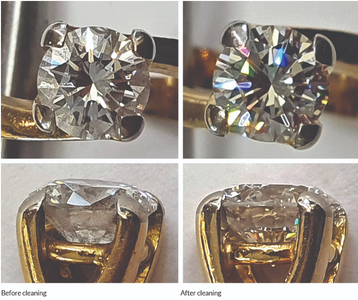
Dirt kills fire and life. The RI on the pavilion interface is critical (pun).
Interesting that many of the people on this forum love old cut diamonds that have very very slow virtual facet speed?The pavilion angle is critical for "VF speed" = DETAS. Shallow diamonds have much less VF speed than diamonds with Cr34.5 P41-41.2 angles.
- Joined
- Aug 15, 2000
- Messages
- 18,863
And which diamonds did you compare in your World Comparisons? How did you assess the difference in the degree of dirtiness between the compared diamonds in these comparisons?
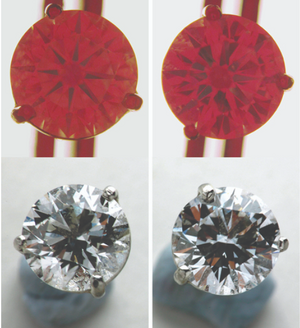
I did a shallow diamond earring test to prove the point for Peter Yantzer, then the Director of the AGS lab. We had debated shallow cuts and viewing distances for years. In 2005, I replaced one of Drena's earring ideal cut stones with a shallow diamond. The shallow stone had a 59.5% table, 31.3° crown and 40.6° pavilion with not very good symmetry. That equates to cut grades of GIA Good or AGS 3 or 4. The remaining ideal cut diamond had a 55.3% table, 34.9° crown and 40.75° pavilion with perfect optical symmetry (hearts and arrows).
After 3 months of annoying many people by asking which looked better, there was no doubt that the shallow stone performed better in all sorts of lighting environments. Clean or dirty. I had my Drena swap ears with the diamonds every day to ensure they were equally dirty. That was when I discovered that shallow diamonds lose less brilliance when dirty. Peter also preferred the dirty shallow diamond earring, much to his surprise.
- It's precisely because dirt almost completely diminishes Fire, Brilliancy, and Scintillation that it's entirely futile to compare the Optical Performance of dirty diamonds with P40.6 and P41. These proportions only make sense to compare for clean diamonds because the differences in Optical Performance that exist can only be observed in clean diamonds. The error in HCA cannot be rectified through dirty diamonds. The argument involving dirty diamonds wouldn't even stand up to a simple objective test.
- Some consumers indeed prefer Old Mine cuts over Modern cuts, but in my observations, this is primarily because they are distinct from the Modern Cut, which has become a commodity and lost its uniqueness. Cuts with larger facets like Old Mine Cut and Emerald have significant bursts of Fire, which are very beautiful. However, your assertion that Old Mine cuts have a very, very slow virtual facet speed does not correspond to reality and indicates a misunderstanding of what virtual facet speed entails. While increasing the size of virtual facets reduces a diamond's overall ETAS and DETAS, the speed of an individual facet depends on the angle relationship between the incoming and outgoing angles. VF Old Mine cuts can have both high and low speeds, depending on the crown and pavilion angle ratio of a specific cut. In other words, the average virtual facet speed of Old Mine cuts may be higher than that of Modern Cuts, and this is crucial for seeing more significant bursts of Fire and deriving pleasure from the changing colors of the flashes when the diamond is tilted.
I did a shallow diamond earring test to prove the point for Peter Yantzer, then the Director of the AGS lab. We had debated shallow cuts and viewing distances for years. In 2005, I replaced one of Drena's earring ideal cut stones with a shallow diamond. The shallow stone had a 59.5% table, 31.3° crown and 40.6° pavilion with not very good symmetry. That equates to cut grades of GIA Good or AGS 3 or 4. The remaining ideal cut diamond had a 55.3% table, 34.9° crown and 40.75° pavilion with perfect optical symmetry (hearts and arrows).
After 3 months of annoying many people by asking which looked better, there was no doubt that the shallow stone performed better in all sorts of lighting environments. Clean or dirty. I had my Drena swap ears with the diamonds every day to ensure they were equally dirty. That was when I discovered that shallow diamonds lose less brilliance when dirty. Peter also preferred the dirty shallow diamond earring, much to his surprise.
The shallow stone had a 59.5% table, 31.3° crown and 40.6° pavilion with not very good symmetry.
P40.6 Cr31.3 is similar in optical properties to a diamond with P40 Cr34.5 angles.

VG Round, 1.51ct, G, SI2, EX, VG, NON, -1.7%
VG Round, 1.51ct, G, SI2, EX, VG, NON, -1.7%
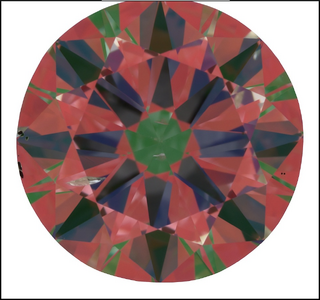
- P40 Cr34.5 is very different from P40.6 Cr34.5, which we are comparing to P41 Cr34.5.
- Such stones exhibit very strong Body Obscuration; in fact, they have significant Dead Zones (black areas that remain black even during tilting). While dirt doesn't significantly worsen their Optical Performance because they are very dark even in a clean state.
- There are shallow stones that appear much brighter when viewed perpendicular to the table than P40.8 Cr34.5, but they have weak contrast, low Fire, and practically fade at slight angles.
Last edited:
- Joined
- Aug 15, 2000
- Messages
- 18,863
I think you are running out of steam Sergey?P40.6 Cr31.3 is similar in optical properties to a diamond with P40 Cr34.5 angles.

VG Round, 1.51ct, G, SI2, EX, VG, NON, -1.7%
VG Round, 1.51ct, G, SI2, EX, VG, NON, -1.7%cutwise.com
Do you really recommend that customers purchase P40 Cr34.5, P40.6 Cr31.3 stones instead of P40.8 Cr34.5?
- P40 Cr34.5 is very different from P40.6 Cr34.5, which we are comparing to P41 Cr34.5.
- Such stones exhibit very strong Body Obscuration; in fact, they have significant Dead Zones (black areas that remain black even during tilting). While dirt doesn't significantly worsen their Optical Performance because they are very dark even in a clean state.
- There are shallow stones that appear much brighter when viewed perpendicular to the table than P40.8 Cr34.5, but they have weak contrast, low Fire, and practically fade at slight angles.
That stone in Drena's earrings is too shallow even for HCA to recommend.
It was to prove a point - and even when clean it was preferred by most observers. However, you fail to understand that observer obstruction is hardly an issue for earrings and pendants because of personal space.
Even the wearer has double the viewing distance because they must look in a mirror.
And diamonds with shallower proportions are not ones I recommend for rings:
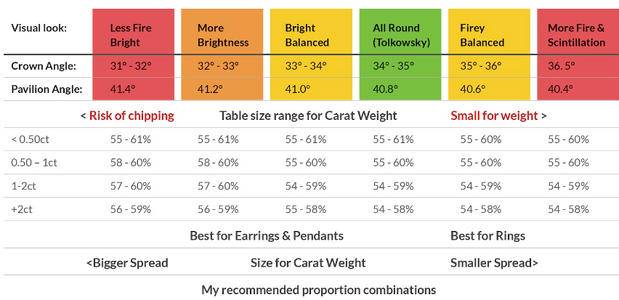
- Joined
- Aug 15, 2000
- Messages
- 18,863
Here is the original photo I took in the hotel room after dinner with Peter Yantzer and several others including John Pollard and maybe Wink Jones from memory?
Along with the original Ideal-scope reference chart from more than 20 years ago.
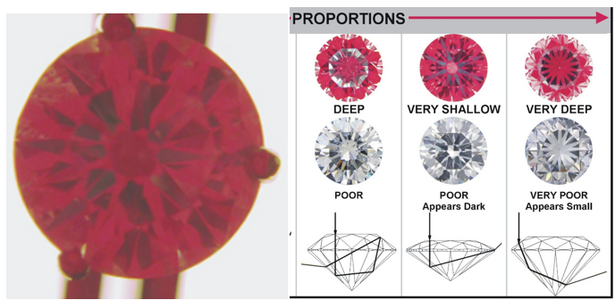
And I know you will love to point out the error in the shallow ray path stone - because it goes straight back to the observers head.
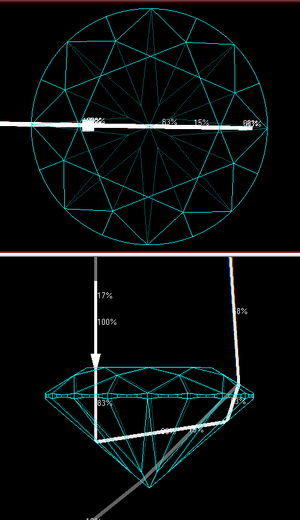
But as you know - for earrings the observer is much further away and so that argument does not hold unless the observer is like these two:

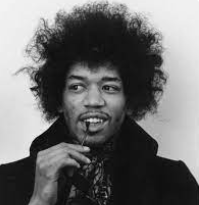
For diamonds with larger tables, as I recommend with shallow stones, there is a much larger area of minor pavilion facet than for diamonds with the Firey proportions and smaller tables.
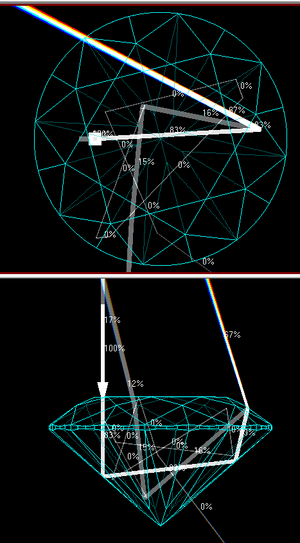
And finally, larger tables mean 90% of the light "seen" by an observer from the crown facets on big table diamond is also entering the stone from an oblique angle.
Why not make a DiamCalc model with a pavilion with 1.4-1.5 RI Sergey?
Along with the original Ideal-scope reference chart from more than 20 years ago.

And I know you will love to point out the error in the shallow ray path stone - because it goes straight back to the observers head.

But as you know - for earrings the observer is much further away and so that argument does not hold unless the observer is like these two:


For diamonds with larger tables, as I recommend with shallow stones, there is a much larger area of minor pavilion facet than for diamonds with the Firey proportions and smaller tables.

And finally, larger tables mean 90% of the light "seen" by an observer from the crown facets on big table diamond is also entering the stone from an oblique angle.
Why not make a DiamCalc model with a pavilion with 1.4-1.5 RI Sergey?
Garry,I think you are running out of steam Sergey?
That stone in Drena's earrings is too shallow even for HCA to recommend.
It was to prove a point - and even when clean it was preferred by most observers. However, you fail to understand that observer obstruction is hardly an issue for earrings and pendants because of personal space.
Even the wearer has double the viewing distance because they must look in a mirror.
And diamonds with shallower proportions are not ones I recommend for rings:

I think you are running out of steam Sergey?
On what basis did you come to this conclusion? It seems like you are mistaking your desires for reality. I am systematically trying to understand your statements and the sources of these statements.
For example,
That stone in Drena's earrings is too shallow even for HCA to recommend.It was to prove a point - and even when clean it was preferred by most observers.
If, during your research, you found that most observers prefer stones with proportions Pv 40.6 Cr31.3 (=P40 Cr34.5) over stones with proportions P40.8 Cr34.5 and good symmetry, this implies that:
- Either all existing or past diamond evaluation systems on the diamond market (HCA, GIA, AGS, IGI, Sarin, Octonus) are significantly flawed,
- Or you conducted the testing incorrectly.
I observe the same behavior now. If you want to conduct a genuinely useful and effective assessment of diamond beauty, you need to stop ignoring facts and opinions that don't confirm your hypotheses.
Based on my experience, I know that conducting a truly valid survey of consumers and experts comparing 2-3 diamonds is extremely difficult. More than 90% of experts immediately take the diamond in their fingers and start examining the stones under a loupe. Very rarely are there professionals who compare diamonds without a loupe, place them under a spotlight to create Fire, and hold the diamonds in tweezers to avoid getting them dirty right away. Practically no one knows what Fire and Brilliancy are. At the same time, comparing two diamonds weighing less than 1 carat is almost meaningless, especially when surveying consumers who don't have experience constantly viewing such small objects. Their eyes and brains simply lack the skills to distinguish details in such small objects. Just as with wine tasting, food, and works of art, extensive experience is needed to learn to see and feel the small but significant differences between the ordinary and the outstanding."
- Joined
- Aug 15, 2000
- Messages
- 18,863
You were one of the only people who I allowed to examine the diamonds in your hands Sergey (apart from some of my team at work).Garry,
On what basis did you come to this conclusion? It seems like you are mistaking your desires for reality. I am systematically trying to understand your statements and the sources of these statements.
For example,
If, during your research, you found that most observers prefer stones with proportions Pv 40.6 Cr31.3 (=P40 Cr34.5) over stones with proportions P40.8 Cr34.5 and good symmetry, this implies that:
I lean toward the second option because I also participated in this testing. As far as I remember, the testing in my case went as follows:You asked me to look at earrings worn by Drena. Since the earrings were on Drena at that moment, and I was sitting in some restaurant or cafe across from her, I was utterly perplexed about what I should do. Then you asked Drena to take off the earrings and handed them to me. I was amazed and confused, but you explained that you do this regularly, and it's perfectly fine. I took the earrings, examined them, and honestly stated that I saw no difference. You immediately proclaimed with joy that this proves your theory that dirt has less impact on the beauty of shallow diamonds than on diamonds with classic proportions. In some sense, this is probably a valid statement, as you can't take away something from a diamond that it doesn't have. However, this does not mean that I voted for Pv 40.6 Cr31.3. I'm afraid that in most other cases, you interpreted the results of these surveys in a similar way. You heard only what you wanted to hear, only what confirmed your beliefs and assertions, and ignored most that didn't support your hypotheses.
- Either all existing or past diamond evaluation systems on the diamond market (HCA, GIA, AGS, IGI, Sarin, Octonus) are significantly flawed,
- Or you conducted the testing incorrectly.
I observe the same behavior now. If you want to conduct a genuinely useful and effective assessment of diamond beauty, you need to stop ignoring facts and opinions that don't confirm your hypotheses.
Based on my experience, I know that conducting a truly valid survey of consumers and experts comparing 2-3 diamonds is extremely difficult. More than 90% of experts immediately take the diamond in their fingers and start examining the stones under a loupe. Very rarely are there professionals who compare diamonds without a loupe, place them under a spotlight to create Fire, and hold the diamonds in tweezers to avoid getting them dirty right away. Practically no one knows what Fire and Brilliancy are. At the same time, comparing two diamonds weighing less than 1 carat is almost meaningless, especially when surveying consumers who don't have experience constantly viewing such small objects. Their eyes and brains simply lack the skills to distinguish details in such small objects. Just as with wine tasting, food, and works of art, extensive experience is needed to learn to see and feel the small but significant differences between the ordinary and the outstanding."
You invalidated the experiment.
There were no others who did not prefer the dirty shallow over the dirty ideal cut.
You were one of the only people who I allowed to examine the diamonds in your hands Sergey (apart from some of my team at work).
You invalidated the experiment.
There were no others who did not prefer the dirty shallow over the dirty ideal cut.
Who else (apart from some of Garry's team at work) can describe on Pricescope or in private correspondence what exactly they saw and how they assessed during this experiment?
Share:
Past, Present, Future: The Meaning of Three-Stone Engagement Rings Past, Present, Future: The Meaning of Three-Stone Engagement Rings - 04/14
Past, Present, Future: The Meaning of Three-Stone Engagement Rings - 04/14


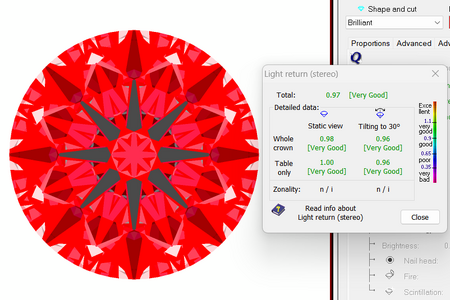

300x240.png)